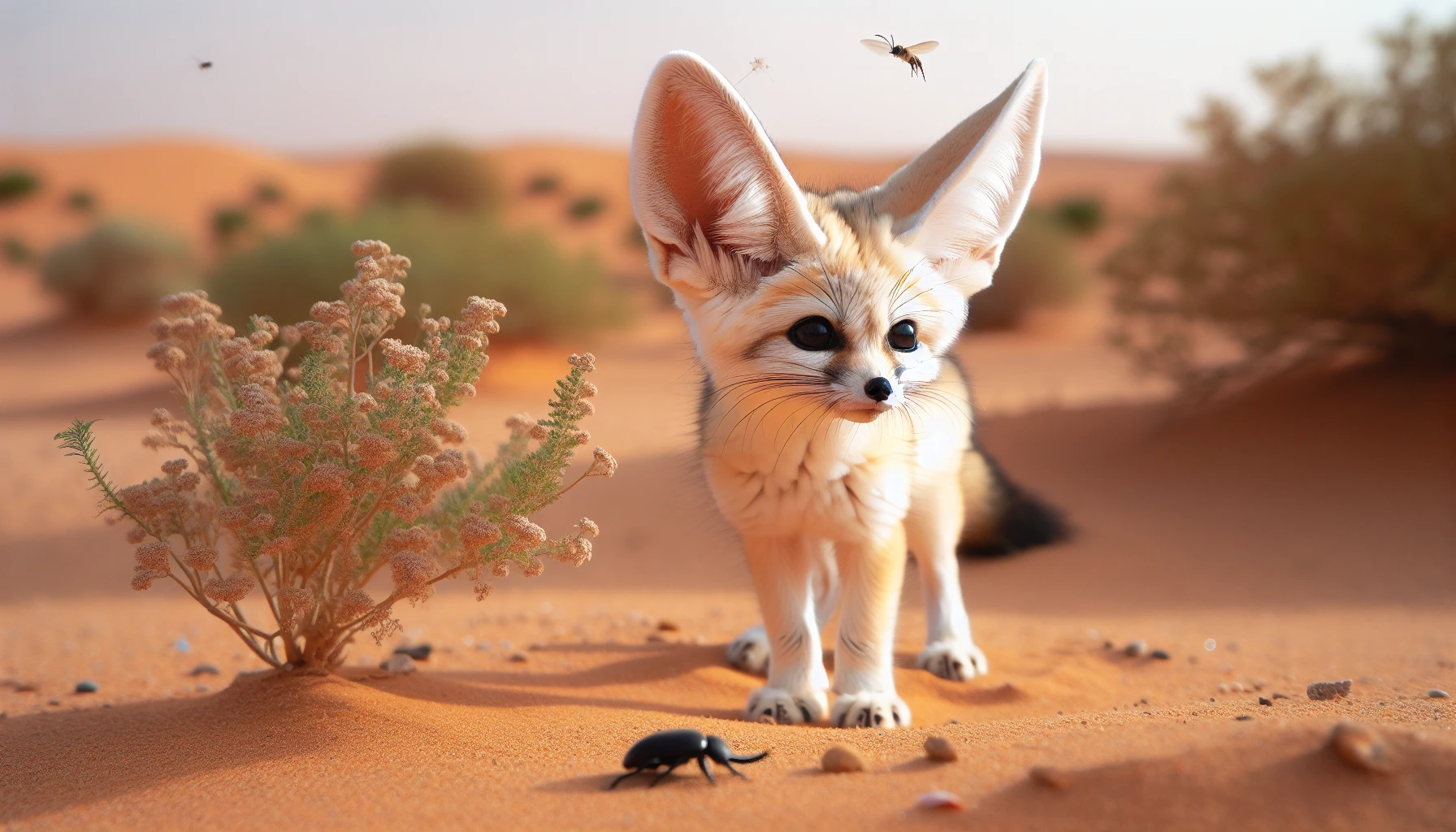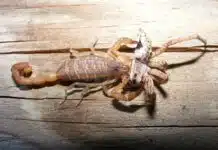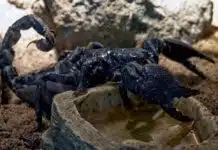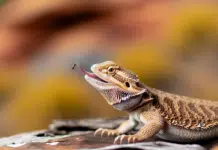Ever wondered how the adorable fennec fox survives in the harsh desert environment? Well, it’s not easy, but these small, resourceful creatures have developed some fascinating adaptations to help them thrive. Let’s dive into the world of the fennec fox and discover “what do fennec fox eat” and how their unique features assist them in locating food and staying hydrated in the unforgiving desert.
Key Takeaways
- Fennec foxes are omnivorous creatures native to North Africa, using their senses and agility to hunt prey in the sand.
- They need a balanced diet of proteins, fats, plant-based nutrients & taurine for optimal health.
- Fennec foxes face threats from both predators and human activities so it’s important to take action for conservation.
Fennec Fox Feeding Habits

Fennec foxes, with their iconic large ears and sand-colored fur, are truly one of the most intriguing desert dwellers. Native to North Africa, including the regions of Northern Africa, these omnivorous animals have adapted their diet to the scarce resources available in their sandy habitat, where wild fennec foxes live. Observing two fennec foxes interact, one can see how they not only hunt for insects and small mammals, but also forage for leaves, roots, and fruits to satisfy their nutritional needs.
These little creatures have developed some fascinating adaptations that help them locate and capture prey, even allowing them to kill prey larger than themselves. Their oversized, bat-like ears grant them the ability to hear even the subtlest noises of prey, while their nimble bodies grant them the agility to swiftly move and surprise their prey.
Omnivorous Appetite
Fennec foxes are adaptable eaters, consuming a variety of foods depending on what’s available in their desert environment. In the wild, they mainly feast on insects, small rodents, lizards, birds, and their eggs, as well as plant matter such as roots, fruits, and leaves. These nocturnal animals are particularly fond of beetles, locusts, termites, scorpions, and spiders, all of which are abundant in the Sahara Desert.
Their ability to switch between animal and plant-based food sources makes them versatile and resilient, allowing them to survive in a challenging environment where resources are often scarce. As opportunistic eaters, fennec foxes play a crucial role in maintaining balance within the desert ecosystem.
Hunting Techniques
Fennec foxes, which inhabits small sand dunes, are masters of stealth, using their keen senses and agile bodies to hunt for prey in small sand dunes. They rely on their excellent hearing to locate prey hidden beneath the sand, and their nimble paws allow them to quickly dig and uncover their next meal. These desert dwellers are also known for their stock spring pounce method; upon hearing their prey, they leap into the air and capture it mid-jump.
Their hunting skills are further enhanced by their capacity to traverse the vast treeless sand areas swiftly and silently. The fennec’s fur-covered feet not only protect them from the scorching hot sand but also facilitate walking on loose sand without making much noise, enabling them to stalk their prey undetected.
Food and Hydration
One of the most remarkable aspects of the fennec fox’s diet is their ability to obtain hydration from the food they consume. In the arid desert environment, direct water sources are scarce, but these resourceful animals have adapted to get most of their moisture from the food they eat, such as leaves, roots, and fruits.
When water is available, fennec foxes will drink, but their primary source of hydration comes from their natural diet. This adaptation allows them to survive in an environment where water is often hard to come by, ensuring they remain healthy and well-hydrated even during long periods without direct access to water.
The Fennec’s Foraging Challenges

Life in the desert is not easy for fennec foxes, as they face numerous challenges in finding food. The arid conditions and sparse vegetation limit their food choices, forcing them to adapt their diet to whatever resources are available in their dry habitat. In addition to the harsh environment, fennec foxes also face competition from other desert predators, such as rodents, reptiles, and insects, as they all vie for the same limited food sources.
Human activities also pose a threat to fennec foxes’ foraging efforts. Road construction, new human settlements, and habitat loss due to urbanization all contribute to the disruption of their natural environment, making it harder for them to find food. To cope with these challenges, fennec foxes employ various survival strategies, such as cutting back on food during water scarcity and relying on their incredible adaptability to make the most of their limited resources.
Scarcity and Competition
Food scarcity is a constant challenge for fennec foxes in the desert. When their preferred food sources like insects, small mammals, and plant matter are scarce, these resourceful animals turn to vegetation like cactus fruits and tomatoes to sustain themselves. Their ability to survive on a varied diet enables them to adapt to changing conditions and make the most of the limited resources available in their environment.
Competition with other desert predators further complicates the fennec fox’s foraging efforts. They must contend with animals like rodents, reptiles, insects, and even larger predators like birds of prey and snakes for food. To overcome these challenges, fennec foxes rely on their unique adaptations, such as their keen hearing, exceptional digging skills, and ability to conserve water, to locate and secure food in a competitive environment.
Human Impact
Human activities have had a significant impact on fennec fox habitats and food sources. Some of the impacts include:
- Habitat loss due to the construction of roads and new human settlements
- Decrease in available food sources
- Increased disturbance from human settlements, negatively affecting foraging and hunting behavior
These factors have led to a decline in fennec fox populations and pose a threat to their survival.
Urbanization further compounds the challenges faced by fennec foxes in their search for food. Expanding cities encroach upon their natural habitat, shrinking the areas in which they can hunt and forage. As their environment becomes increasingly fragmented and disrupted, fennec foxes must adapt and employ various survival strategies to find food and thrive in a rapidly changing world.
Nutritional Needs and Domestic Diets

Whether in the wild or as domestic pets, fennec foxes require a balanced diet of natural whole foods to support their unique physiology and ensure their health and well-being. In the wild, they consume a mix of proteins, fats, and plant-based nutrients, all of which are essential for their survival in the harsh desert environment.
When kept as pets, it is important to provide a diet that closely mimics their natural food sources. This includes a variety of meats, fruits, and vegetables, as well as insects and other foods that are part of their natural diet in the wild. By providing a balanced and appropriate diet, pet owners can ensure that their fennec foxes receive all of the essential nutrients they need to thrive.
Essential Nutrients for Fennecs
A healthy diet for fennec foxes should include a mix of:
- Proteins, which provide essential amino acids for growth, repair, and maintenance of body tissues
- Fats, which serve as a concentrated energy source and aid in insulation and organ protection
- Plant-based nutrients, such as vitamins and minerals, which contribute to overall health and support the immune system.
In addition to these basic nutrients, fennec foxes also require taurine, an important amino acid for metabolic processes. Taurine is particularly important for the proper development and function of the fennec fox’s digestive system, which is adapted to process their natural diet of insects, small rodents, and plant matter.
Feeding Fennec Foxes at Home
Feeding fennec foxes at home requires careful consideration of their dietary needs and preferences. Pet owners should provide a diet that closely mimics their natural food sources, including:
- Meats
- Fruits
- Vegetables
- Insects
- Other foods that are part of their diet in the wild
Processed foods, grains, and high-mercury seafood should be avoided, as they can be harmful to the health of fennec foxes.
It is essential to ensure that pet fennec foxes receive a balanced and appropriate diet that provides all of the essential nutrients they need to thrive. This includes providing a variety of fresh produce, raw meat, and insects to mimic their natural diet and ensure they receive a mix of proteins, fats, and plant-based nutrients.
Predation and the Food Chain

Fennec foxes have a notable role in the desert food chain, acting both as predators and prey. As predators, they help control the populations of rodents, insects, and other small animals in their desert habitat, contributing to the maintenance of a balanced ecosystem. However, they also face threats from larger predators, such as owls, jackals, and hyenas, as well as human activities like poaching and the pet trade.
Understanding the role fennec foxes have in the desert food chain is key for the conservation of their species and the upkeep of the fragile desert ecosystem. By learning more about their unique dietary adaptations and the challenges they face in their environment, we can better appreciate the significance of these captivating creatures and the important role they play in their habitat.
Fennec Foxes as Predators
As predators, fennec foxes have a key role in regulating the populations of rodents, insects, and other small desert creatures in their habitat. Their keen senses, exceptional hunting skills, and omnivorous diet enable them to eat rodents, adapt to the challenging conditions of their environment, and efficiently locate and capture prey.
By consuming a variety of prey species, fennec foxes help maintain balance in the desert ecosystem. Their role as predators contributes to the overall health of their habitat and the populations of other desert animals, ensuring the continued survival and well-being of the diverse desert community.
Threats from Above and Beyond
Despite their status as predators, fennec foxes face threats from larger predators as well as human activities. In the wild, they may be targeted by animals such as owls, jackals, and hyenas, which can pose a significant danger to their survival. In addition to these natural predators, fennec foxes are also at risk from human activities like poaching for the pet trade and hunting for their fur.
To safeguard fennec fox populations and ensure their ongoing existence in the desert ecosystem, it is necessary to:
- Tackle threats such as habitat loss, climate change, and illegal activities
- Advocate for conservation efforts and raise awareness of the challenges faced by fennec foxes
- Support initiatives that protect their habitat and combat illegal activities
By doing so, we can help safeguard these remarkable creatures and the delicate desert ecosystem they call home.
Unique Dietary Adaptations

Fennec foxes have developed a number of unique adaptations that aid in their hunting and foraging efforts. Their oversized, bat-like ears help them detect prey and release heat in the desert environment, while their thick fur offers insulation and shields them from severe temperatures. These adaptations, along with their omnivorous diet and versatile hunting techniques, allow fennec foxes to thrive in the harsh desert environment and play a crucial role in the desert food chain.
Understanding the fennec foxes’ distinctive dietary adaptations not only offers insights into their survival strategies but also underscores the importance of preserving their habitat and safeguarding their populations. By appreciating the remarkable abilities of these captivating creatures, we can better understand their role in the desert ecosystem and work towards ensuring their continued survival and well-being.
Remarkable Ears for Hunting
The large, bat-like ears of the fennec fox serve a crucial role in their hunting and survival. These remarkable ears enable them to detect the faintest sounds of potential food sources, such as insects and small mammals hidden beneath the sand. Additionally, their ears help dissipate heat, allowing them to regulate their body temperature in the extreme desert environment.
This unique adaptation not only aids in locating prey but also enables fennec foxes to survive in the harsh desert conditions. Their exceptional hearing allows them to efficiently locate and capture food, while their heat-radiating ears help them maintain a stable body temperature despite the extreme heat of their habitat.
Dense Fur for Extreme Climates
Fennec foxes possess dense fennec’s fur that plays a vital role in their survival in the extreme desert environment. Their thick fur provides insulation and protection from the desert heat and scorching sun during the day, and keeps them warm during the cold desert nights. In addition, their fur-covered feet enable them to walk on hot sand without burning their paws, allowing them to traverse the desert with ease.
This unique adaptation is essential for fennec foxes, as it allows them to withstand the extreme temperatures of their habitat and continue their hunting and foraging efforts. Dense fur provides the necessary protection and insulation needed to survive in the harsh desert climate, ensuring their survival and ability to fulfill their role in the desert food chain.
Breeding Season and Feeding
During breeding season, fennec foxes experience heightened nutritional needs and must cater for their offspring. Mating season requires them to consume more food to support their energy demands and reproductive success. As parents, they must find and provide adequate food sources for their growing pups, ensuring their survival in the harsh desert environment.
Comprehending the dietary needs and challenges that fennec foxes face during breeding season is pivotal for their species’ conservation. By learning more about their nutritional requirements and the strategies they employ to provide for their offspring, we can better appreciate the significance of these captivating creatures and the important role they play in their habitat.
Increased Nutritional Demand
During mating season, fennec foxes need more food to sustain their energy requirements and reproductive success. They may need to consume more protein-rich foods, such as insects, small rodents, and small birds, to meet their increased nutritional needs. However, specific information on the exact nutritional requirements during mating season is scarce.
The higher nutritional need during mating season can also affect the behavior of male fennec foxes, making them more territorial and aggressive towards other males. This increased aggression ensures they can mate and provide for their offspring, which is essential for the continued survival and well-being of their species.
Provisioning for Pups
Parent fennec foxes have a critical role in their offspring’s survival by providing them with sufficient food sources during their early development. In the wild, they must hunt at night to find food for their babies, taking advantage of the cooler temperatures and their nocturnal nature. Parents must ensure that their pups receive a balanced diet that includes both animal protein and plant matter, as well as fresh water.
By understanding the importance of provisioning for their pups and the challenges faced by fennec fox parents in the desert, we can better appreciate the efforts these dedicated animals put into ensuring the survival of their offspring. This insight into the unique breeding and feeding habits of fennec foxes highlights the importance of conserving their habitat and protecting their populations for future generations.
Summary
Throughout this journey into the fascinating world of the fennec fox, we have explored their unique dietary adaptations, hunting techniques, and the challenges they face in the harsh desert environment. These captivating creatures play a crucial role in the desert ecosystem as both predators and prey, and their survival is dependent on their remarkable adaptations and resourcefulness. By understanding and appreciating the incredible resilience and adaptability of the fennec fox, we can work towards conserving their habitat and ensuring the continued survival of this extraordinary desert dweller.
Frequently Asked Questions
Do fennec foxes eat eggs?
Yes, fennec foxes eat eggs as part of their diet. They are opportunistic eaters who also feed on rodents, reptiles, and insects.
What do fox eat in the wild?
Foxes are omnivorous, hunting rabbits, rodents, birds, frogs and earthworms as well as scavenging carrion. They also eat vegetation, fruits, nuts, insects, and garbage. Red foxes may even cache excess food and mark it with urine.
Is a fennec fox a herbivore or carnivore?
Fennec foxes are omnivores, enjoying a diet that includes both plant-based food sources like roots, berries and fruit, as well as small rodents, lizards, insects and eggs.
Can fennec foxes eat dates?
Fennec foxes are known to eat dates collected on the ground, in addition to their typical diet of small rodents and birds.
How do fennec foxes stay hydrated in the desert?
Fennec foxes stay hydrated by eating food such as leaves, roots, and fruits that provide them with enough moisture. They are also able to survive without direct access to water sources for long periods of time.



![Sick Axolotl, Fungus, Stress Symptoms [Axolotl Illness Guide 2025] Axolotl fungus](https://exopetguides.com/wp-content/uploads/2018/06/axolotl-218x150.jpg.webp)
















